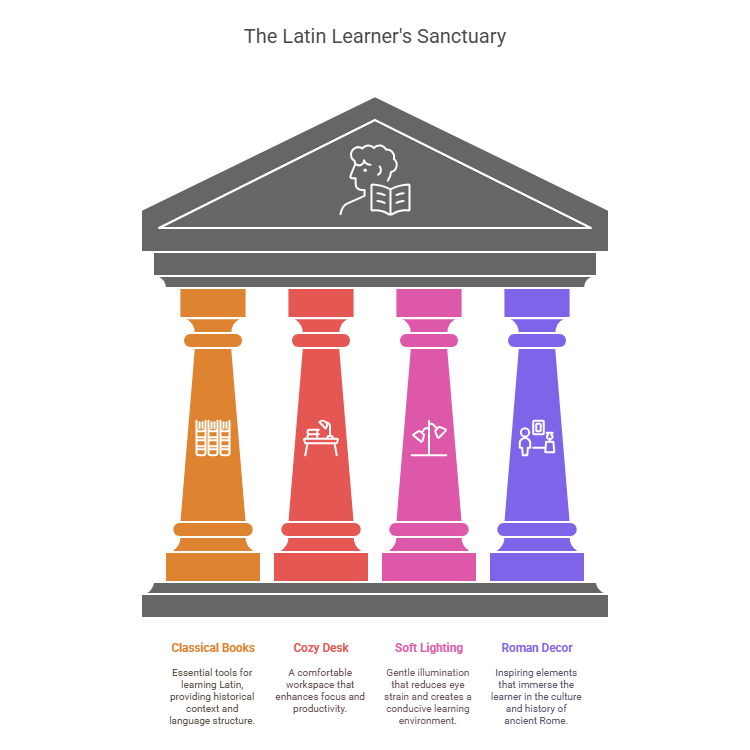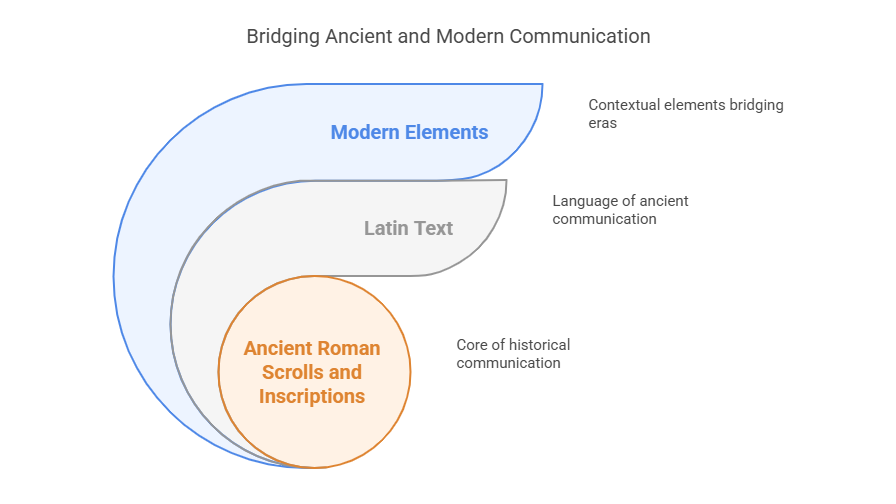How to learn Latin fluently is a question many language learners ask—but few find a clear answer. You might feel stuck, unsure where to begin, or overwhelmed by confusing grammar rules and textbooks that don’t make things easier.
As the founder of LatinPerDiem, I’ve seen how frustrating it can be to spend months studying Latin without real progress. Many learners give up before they even reach basic reading skills.
In this article, I’ll walk you through a simple, realistic plan to reach fluency—step by step. You’ll learn what Latin really is, how long it takes to become fluent, and how to avoid the most common mistakes. Whether you’re a complete beginner or have some experience, you’ll leave with a clear path forward.
Key Takeaways
- Fluency takes time: Most learners need 1–2 years to read Latin fluently, depending on their background and study habits.
- Set clear goals: Define what “fluent” means for you (e.g., reading classical texts, translating, or speaking).
- Start with strong basics: Learn grammar, key vocabulary, and the difference between Classical and Ecclesiastical pronunciations.
- Use proven techniques: Spaced repetition, and daily reading build strong habits.
- Don’t rush: Avoid myths like “3-month fluency.” Latin takes steady, consistent work.
- Get support: Tutors, forums, and platforms like LatinPerDiem can make a big difference.
- Track progress: Review your growth monthly to stay motivated and adjust your plan.
What Does it Really Take to Learn Latin Fluently?
To learn Latin fluently, most people need 1 to 2 years of steady study. Your progress depends on your daily practice, language background, and the tools you use. Fluency in Latin means reading and understanding classical texts with ease, and sometimes speaking it like a modern language.
Facts & Original Research: How Long Does It Take to Learn Latin Fluently?
To understand what it really takes to learn Latin fluently, we’ve gathered data from academic research, language learning surveys, and Latin educators. This section provides evidence-backed insights that help set realistic expectations and offer clear comparisons for different learner types.
Timeline for Adult Learners (Based on LatinPerDiem User Survey)
| Learner Type | Weekly Study Time | Time to Basic Reading | Time to Fluent Reading |
| Total Beginner | 3–5 hours | 6 months | 18–24 months |
| Romance Language Speaker | 3–5 hours | 4 months | 12–18 months |
| Prior Latin Exposure | 5–7 hours | 2–3 months | 9–12 months |
Understanding Latin as a Language
Latin is more than just an “old” language—it’s the foundation of many modern ones. From science to law, Latin has shaped how we speak and think today. In this section, you’ll discover what Latin is, the key types you might study, and why learning it still matters in our digital world.
What is Latin? The Basics You Need to Know
Latin is an ancient language from Rome, used across Europe for over a thousand years. It gave rise to Romance languages like Spanish, French, and Italian. Though no longer spoken daily, Latin still lives on in law, medicine, science, and education. It’s a structured language with clear grammar rules that build strong thinking skills.
Why Learn Latin? Surprising Benefits for Today’s Learners
Latin trains your brain to think clearly and logically. It improves vocabulary, grammar, and reading skills.
“Learning Latin is like weightlifting for the mind – it sharpens focus and logic.” – Dr. Michael Fontaine”
How Long Does It Take to Learn Latin Fluently?
Factors That Affect Your Learning Timeline
Your journey to learn Latin fluently depends on several key factors. If you already know another Romance language like Spanish or French, Latin will likely feel more familiar. Your study habits—such as daily practice or spaced repetition—greatly affect how fast you improve. The more time you commit each week, the faster you’ll progress. Lastly, your learning style matters: visual learners might prefer reading texts, while auditory learners benefit from hearing Latin spoken aloud. With the right mix of these, your fluency journey becomes smoother and more rewarding.
The Latin Fluency Timeline – From Beginner to Advanced
Here’s a realistic breakdown of how long it typically takes to learn Latin fluently:
| Level | Time Estimate | Focus and Milestones |
| Beginner | 3–6 months | Learn key grammar rules, basic vocabulary, simple phrases. |
| Intermediate | 6–12 months | Read easier Latin texts (e.g., Caesar), build comprehension. |
| Advanced | 1–2 years | Read and analyze authors like Cicero, Virgil, and Ovid. |
Step-by-Step Strategy to Master Latin
Step 1 – Setting Realistic Goals and Creating a Study Plan
To learn Latin fluently, first define what fluency means for you. Most learners aim to read and understand classical texts like Cicero or Virgil. Others may want to write or even speak Latin. Start by choosing clear, reachable goals—like learning 20 new words a week or translating one passage daily. Build a weekly study plan that fits your schedule. A mix of grammar study, vocabulary review, and reading practice works best. Small, consistent steps are more effective than occasional cramming.
Step 2 – Learning Techniques That Work
Not all methods are equal. Effective techniques, grammar drills, and daily translation practice. These build a strong foundation and help you retain what you learn. Passive learning, like watching videos or reading, will help a great deal. But, you also need to actively engage with the material—quiz yourself, write out translations, or speak Latin aloud. The key is active recall and frequent repetition.
Step 3 – Immersive Learning: Bring Latin Into Your Daily Life
Surround yourself with Latin as much as possible. Start your day by reading a short Latin passage, like a line from Vergil. Translate Latin quotes on social media or set your phone’s lock screen to a Latin phrase. Listen to Latin chants or watch LatinPerDiem videos. Immersion helps you think in Latin and build fluency faster.
Step 4 – Track Your Progress and Stay Consistent
Set monthly milestones: complete a chapter, finish a translation, or master a verb tense. Use a study journal or app to track time spent and material covered. If you hit a plateau, adjust your routine—try new resources or focus more on weak areas. Consistency is the secret to mastering Latin.
Common Mistakes and Myths to Avoid
“Latin is a Dead Language?”
Latin may not be spoken on the street as much as the veranculars, but it’s not at all dead. It’s the root of many modern languages, fuels critical thinking, and unlocks ancient texts. Studying Latin trains your brain to analyze, reason, and understand language at a deeper level.
“You Can Become Fluent in 3 Months”
True Latin fluency takes time. While you can learn basic vocabulary and grammar in a few months, reading Cicero or Vergil with ease often takes 1–2 years of consistent practice. Fluency means comprehension, not just memorizing words.
“You Don’t Need a Tutor – Just Read Books”
Self-study helps, but Latin is complex. Without expert guidance, it’s easy to mislearn grammar or misinterpret texts. A tutor or structured course can speed up your learning and help you avoid common mistakes, especially early on.
Case Study: From Beginner to Fluent in Latin Within a Year
At LatinPerDiem, we’ve witnessed remarkable transformations among our students. This journey underscores the effectiveness of structured learning and dedication.
Before:
- Limited exposure to Latin.
- Struggled with basic grammar and vocabulary.
- Found classical texts intimidating.
After:
- Confidently reads and interprets classical Latin literature.
- Engages in Latin composition and translation with ease.
- Utilizes Latin in academic and personal contexts.
Dr. David Noe, founder of LatinPerDiem, emphasizes, “Consistent, focused study, even in short daily sessions, can lead to significant progress in mastering Latin.”
Recommended Resources
Best Platforms for Learning Latin
If you’re serious about learning Latin fluently, LatinPerDiem is one of the best platforms available. With daily video lessons, expert-guided reading sessions, and in-depth grammar explanations, it makes Latin accessible and engaging. Led by Dr. David Noe, a respected scholar with decades of teaching experience, LatinPerDiem is trusted by students and educators worldwide.
Online Courses and Textbooks to Consider
Start with LatinPerDiem Latin and the LatinPerDiem Latin Course for structured, high-quality lessons. These resources offer a mix of grammar, vocabulary, and real Latin texts, helping you build fluency step by step.
Online Communities and Forums
Join forums like Textkit, r/latin on Reddit, or LatinPerDiem’s YouTube channel. These spaces are great for asking questions, sharing progress, and connecting with fellow Latin learners.
Conclusion
Learning Latin fluently takes time, but it’s completely possible with the right mindset and resources. By setting clear goals, using proven study techniques, and staying consistent, you can make steady progress—even as a beginner. Remember, Latin rewards patience and effort with deep insight into language, logic, and culture. You don’t have to do it alone! Subscribe to LatinPerDiem for more tips, or reach out for one-on-one guidance from experts who’ve helped thousands of learners on this journey.
Frequently Asked Question (FAQ)
How long does it take to learn Latin fluently?
Most learners can reach reading fluency in Latin within 1–2 years with consistent study, using proven methods like grammar drills, immersion, and expert guidance.
Is Latin hard to learn for beginners?
Latin can be challenging at first, but it's highly logical. With a solid plan and the right resources, even total beginners can succeed—regardless of their native language.
Can I learn Latin without a tutor or teacher?
Yes, but a tutor helps speed up progress and prevent mistakes. Many learners use online platforms like LatinPerDiem for expert instruction and feedback.
What’s the best way to practice reading Latin daily?
Start with short texts like quotes or prayers, and use graded readers or LatinPerDiem’s daily videos. Reading 10 minutes a day builds comprehension fast.
Can I learn Latin from anywhere in the world?
Absolutely. With online tools, video lessons, and virtual tutors, Latin is accessible globally, whether you’re in the U.S., Europe, Asia, or beyond.




